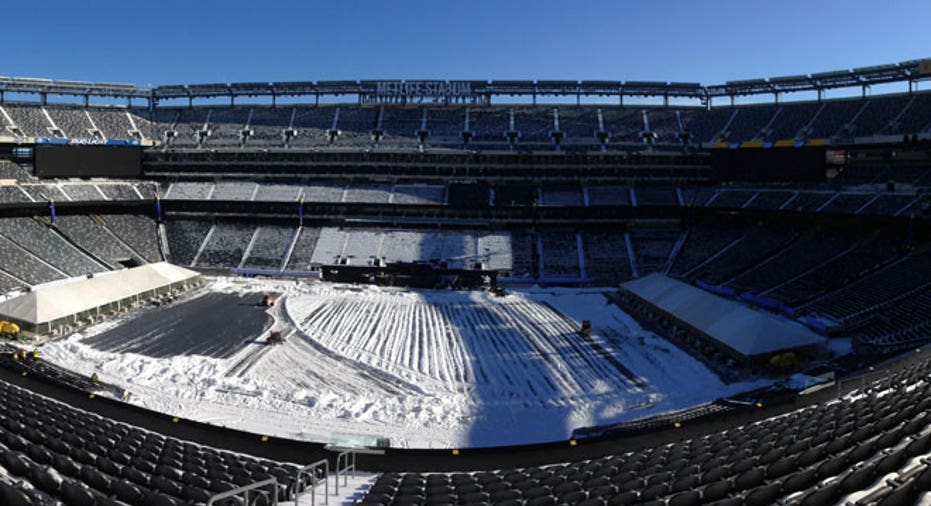What's Keeping Fans Out of Stadiums

Football might be America’s most popular sport, but that doesn’t mean fans are flocking to cheer their teams on in person.
“The at-home experience has gotten better and the stadium experience has plateaued or gotten worse,” says Andrew Billings, Ronald Reagan chair of broadcasting at the University of Alabama.
Most professional sports teams rely on filling stadiums as their main revenue source, but that’s not the case for football. Ironically, it’s the league’s biggest revenue source, TV, that has become its biggest competitor for getting fans in stadium seats.
“It’s a problem of their own creation," says Scott Rosner, practice associate professor of legal studies and business interest at the University of Pennsylvania. “They’ve created such a good TV product that fans don’t feel like they are missing out by staying at home."
Increased ticket prices have also been a major turn off.
The NFL suffered a loss in attendance from 2008 and 2011, which forced the league to change its television black-out rules.
“We want it to be full, but we don’t want to be the ones filling it,” says Billings. “It is the snake starting to eat its own tail. Media rates are going up, but that will soon be depleted if there are empty seats.”
The players on the field see benefits from more connectivity as well. “I think it’s incredibly important for the fans to have that enhanced user experience,” says Adam Carriker, defensive end for the Washington Redskins. “I know my friends and family enjoy using social media during games and I think it bridges the gaps between the live stadium experience and amenities of at-home viewing.”
But Rosner says the league needs to try harder. After all, the price of HD TVs and smartphones have gone down as technology continues to improve, while for the most part, the live-game experience has remained the same. “You drive to the park, go to the stadium, have a hot dog, drink some soda or beer and watch the game. It hasn’t changed in a quarter of a century.”
But for some fans, that’s all about to change.
The new stadium for the San Francisco 49ers will reportedly have the strongest publicly-accessible Wi-Fi network in a sports facility in America, along with perks like being able to check bathroom lines, order food and stream the game -- all from a phone.
In the spring of 2012, NFL Commissioner Roger Goodell announced that all of the league’s stadiums need to be Wi-Fi accessible by the start of the 2015 season. Fans flocking to MetLife stadium this weekend to watch the Seahawks and Broncos compete in Super Bowl XLVIII can rest assured they will be able to tweet, upload, post and text after numerous upgrades were made to the nearly-four-year-old stadium.
Easier Said than Done
According to Roy Choi, managing editor of TechnoBuffalo, 20 out of the 31 stadiums NFL teams play in have Wi-Fi capabilities, and the installation process isn’t easy. “The conservative estimates of what would be required in terms of installation of wireless access points for a stadium of 50,000 seats is about 400 wireless access points. That’s a lot of work and money to get people connected.”
He adds that because the stadiums are mostly concrete, providing constant connectivity is harder, and for most usage, it will be feast or famine. “You have to be able to sustain a high amount of traffic during very short bursts of time -- intermission, touchdowns, commercial breaks.” He says wireless points would have to be placed within a 10-foot radius of fans for them to get the kind of connection they desire.
Financing stadium renovations can also get tricky. “A lot of these stadiums aren’t owned by the teams; they are owned by municipalities and companies and teams have tenant agreements,” says Choi. Venue owners are not used to funding renovations and normally rely on public funds and money from TV contracts.
Keeping pace with technological advancements can also prove to be challenging. “Even if a stadium is finally at the level for fans to connect, download and do everything they need to do, in just two or three years it will be out of date,” says Courtney Brunious, Associate Director of the University of Southern California's Sports Business Institute.
The price tag and process might be headache inducing, but if teams take advantage of the increased connectivity and technological advances it can be a branding dream. “They will be able to directly interact with fans and give them opportunities and experiences that they can only get from the stadium,” says Brunious.
Allowing fans to be able to upload and post pictures online of their experience at the game is essentially free advertising, says Choi. “It helps the brand because the people looking at it think ‘wow, that looks cool, I need to do that.’”